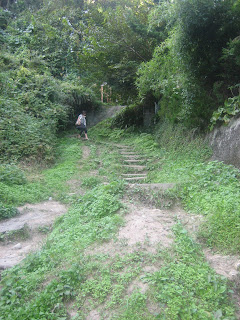On 10/4 I decided to make a day trip out to Kamakura since it's quite close to Tokyo, about an hour south of it. Kamakura is quite steep in history, having 65 temples and 19 shrines with many of them over 800 years old.
Some history.... skip this paragraph if you find history boring. Japan's history is of course filled with civil war after civil war until the Tokugawa (Edo) Period when Tokugawa Ieyasu unified and closed off Japan from the world. During this period of civil war you had different clans fighting amongst themselves to elevate their status. In 1185 a warlord named Minamoto Yoritomo and his brother Yoshitsune defeated the Taira clan. Yoritomo would later turn against his brother who then committed ritual suicide due to paranoia. Yoritomo became the first effective shogun and ruler of Japan. Seven years later he established his military government called the Bakufu in Kamakura. During the next century many monuments were built here, most noteworthy are the great Zen Buddhism Temples built by monks fleeing Song Dynasty China. Zen Buddhism flourished in Japan as the ruling warrior class shared many of their beliefs of devotion to duty and self discipline.
Getting to Kamkura from Tokyo was pretty easy, you can take a local JR (train) from Tokyo stopping at Yokohama along the way. You'll want to get on the Yokosuka line or the Kurihama train.
Most people recommend starting the trip to Kamakura in Kita-Kamakura and walking south through the Daibutsu Hiking trail to the Daibutsu. However having gotten up early for the fish market and having walked quite a bit the day before I was not able to wake up as early as I wanted to, so I decided to start and Kamakura and work my way up to Kita-Kamakura so I would be sure to see Daibutsu.
Daibutsu
Daibutsu is of course Kamakura's most famous site. It is a nearly 800 year old bronze Buddha that has some how survived many floods, typhoons, and earthquakes despite being outside without protection. You can also enter the inside of the Buddha.
Daibutsu is nearly 800 years old, he was was built in 1252. There is also some evidence suggesting he was covered in some gold leaflet (I think) but of course not being covered in some building it was probably destroyed. Daibutsu was actually covered for brief periods of time, but each time the structure built to protect him was destroyed by either flood or fire, I can't quite recall exactly now. Eventually the monks gave up and just left him out in the open.
Great Kannon
Just down the street from Daibutus is the Great Kannon. Kannon is the Goddess of Mercy and predates Daibutsu by 500 years. It is Japan's largest wooden statue. No pictures allowed... of course.
 Koi in the Pond
Koi in the Pond Small Waterfall at the Pond
Small Waterfall at the Pond Commemorating stillborn and aborted children
Commemorating stillborn and aborted children The Temple of the Great Kannon... no pictures of the buhdda allowed.
The Temple of the Great Kannon... no pictures of the buhdda allowed.
 View from Great Kannon
View from Great KannonHiking Trail
After this it was off to the the Daibutsu Hiking course. As I said, I started from Daibutsu instead of from Kita-kamakura. I would not recommend my route as there were plenty of signs pointing to Daibutus but not the other way around. There are a few forks in the hiking trail that could have potentially lead me off the wrong way. Luckily for me I met a nice couple walking their dog that spoke limited English. They were headed the same way as me, so I just walked with them until I reached Zeniarai Benten.
Zeniarai Benten
Zeniarai Benten is really the reason to take the hiking trail. For me this temple was the highlight of Kamakura. Zeniarai Benten is the “Money Washing Benten” dedicated to the goddess of good fortune. In 1185 Minamoto Yoritomo had a dream in which the god Ugafukujin told him there was a magical spring that gushes out of the rocks. Go there and worship the gods of Shinto and peace will come to the people. It is believed that if you spend money that has been washed in the spring's water it will increase many times back and come back to you. It is supposed to at least double in value, but not right away.
 Zeniarai Entrance
Zeniarai Entrance Entrance to the magic spring
Entrance to the magic spring A lady drying her money
A lady drying her money Money Washing Area
Money Washing Area Washing Money
Washing Money More Money Washing
More Money WashingEngaku-ji
At this point it was getting late in the day and as I still had to get to Engaku-ji before it closed. So after hauling ass through a trail I was unfamiliar with I finally got to Engaku with about 30 minutes before it closed. Engaku is probably Kamakura's most satisfying temple. It was built in 1282 by a Chinese Zen monk at the request of Hojo Tokimine to honor victims on both sides of unsuccessful Mongol invasions of 1274 and 1281 (more on this in a later entry). This temple is considered Japan's finest example of Chinese Song dynasty Zen architecture.
One of the places I missed because everything closes at 4 PM was Tokei-ji Temple. This is known as the “Divorce Temple”. Until the mid 19th century women did not have the legal right to seek a divorce. Instead they had to seek refuge at this temple in order to escape domestic abuse and whatever ill treatments they were receiving. Many women did not reach this sanctuary, but those that did automatically received a divorce after three years according to temple law.





















No comments:
Post a Comment